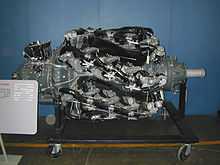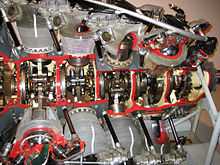Pratt & Whitney R-4360 Wasp Major
| R-4360 Wasp Major | |
|---|---|
 | |
| Pratt & Whitney R-4360 Wasp Major (sectioned) | |
| Type | Four-row Radial engine |
| National origin | United States |
| Manufacturer | Pratt & Whitney |
| First run | 1944 |
| Major applications | B-50 Superfortress C-97 Stratofreighter C-119 Flying Boxcar Convair B-36 Hughes H-4 Hercules Boeing 377 |
| Number built | 18,697 |
| Developed from | Pratt & Whitney R-2180-A Twin Hornet |
| Developed into | Pratt & Whitney R-2180-E Twin Wasp E |
The Pratt & Whitney R-4360 Wasp Major was a large 28-cylinder supercharged air-cooled four-row radial piston aircraft engine designed and built during World War II. It was the last of the Pratt & Whitney Wasp family, and the culmination of its maker's piston engine technology, but the war was over before it could power airplanes into combat. It did, however, power many of the last generation of large piston-engined aircraft before the turbojet and turboprop took over.[1]
Design and development
The R-4360 was a 28-cylinder four-row air-cooled radial engine setup inspiring the engine's "corncob" nickname. Each row of pistons was slightly offset from the previous, forming a semi-helical arrangement to facilitate efficient airflow cooling of the successive rows of cylinders. A mechanical supercharger geared at 6.374:1 ratio to engine speed provided forced induction, while the propeller was geared at 0.375:1 so that the tips did not reach inefficient supersonic speeds.
Although mechanically reliable in flight, it developed an unenviable reputation for in-flight fires, particularly in its Boeing Stratocruiser application, and in addition the Wasp Major was maintenance-intensive. Improper starting technique could foul all 56 spark plugs; requiring hours to clean or replace. As with most piston aircraft engines of the era, the time between overhauls of the Wasp Major was about 600 hours when used in commercial service.
Engine displacement was 4,362.50 cu in (71.489 L), hence the model designation. Initial models developed 3,000 hp (2,240 kW), and later models 3,500 hp, but one model delivered 4,300 hp (3200 kW) using two large turbochargers in addition to the supercharger. Engines weighed 3,482 to 3,870 lb (1,579 to 1,755 kg), giving a power-to-weight ratio of 1.11 hp/lb (1.83 kW/kg).
Wasp Majors were produced between 1944 and 1955; 18,697 were built.
A derivative engine, the Pratt & Whitney R-2180-E Twin Wasp E, was essentially the R-4360 "cut in half". It had two rows of seven cylinders each, and was used on the postwar Saab 90 Scandia airliner.
Variants

- R-4360-4 - 2,650 hp (1,976 kW)
- R-4360-20 - 3,500 hp (2,610 kW)
- R-4360-25 - 3,000 hp (2,237 kW)
- R-4360-41 - 3,500 hp (2,610 kW)
- R-4360-51 VDT - "Variable Discharge Turbine" 4,300 hp (3,210 kW). Intended for B-36C. Used on Boeing YB-50C Superfortress. 2-Power recovery turbines.
- R-4360-53 - 3,800 hp (2,834 kW)
- R-4360-B3 - 3,500 hp (2,610 kW)
- R-4360-B6 - 3,500 hp (2,610 kW)
Applications
- Aero Spacelines Mini Guppy
- Aero Spacelines Pregnant Guppy
- Boeing 377 Stratocruiser
- Boeing B-50 Superfortress
- Boeing C-97 Stratofreighter
- Boeing KC-97 Stratofreighter
- Boeing XF8B
- Boeing XB-44 Superfortress
- Convair B-36
- Convair XC-99
- Curtiss XBTC
- Douglas C-74 Globemaster
- Douglas C-124 Globemaster II
- Douglas TB2D Skypirate
- Fairchild C-119 Flying Boxcar
- Fairchild C-120 Packplane
- Goodyear F2G Corsair
- Hughes H-4 Hercules ("Spruce Goose")
- Hughes XF-11
- Lockheed R6V Constitution
- Martin AM Mauler
- Martin JRM Mars
- Martin P4M Mercator
- Northrop YB-35
- Republic XP-72
- Republic XF-12 Rainbow
- SNCASE SE-2010 Armagnac
- Vultee XA-41
Engines on display
- A R-4360 (TSB1-G) Wasp Major is on display at the New England Air Museum, Bradley International Airport, Windsor Locks, CT.[2]
- Arizona Wing of the Commemorative Air Force, Mesa, AZ
- Pima Air Museum, Tucson, AZ—electric driven cutaway
- Hill Aerospace Museum at Hill Air Force Base, Utah—electric driven cutway
- Hiller Aviation Museum—electric driven cutaway
- Steven F. Udvar-Hazy Center—electric driven cutaway
- Evergreen Aviation & Space Museum, McMinnville, OR—electric driven cut away and one display engine
- Cavanaugh Flight Museum, Addison, TX [3]
Specifications (R-4360-51VDT)

General characteristics
- Type: 28-cylinder supercharged air-cooled four-row radial engine
- Bore: 5.75 inches (146 mm).
- Stroke: 6.00 inches (152 mm).
- Displacement: 4,362.5 cubic inches (71,489 cm3).
- Length: 96.5 inches (2,450 mm).
- Diameter: 55 inches (1,400 mm).
- Dry weight: 3,870 pounds (1,760 kg).
Components
- Valvetrain: Poppet, two valves per cylinder
- Supercharger: Gear-driven single stage variable speed centrifugal type supercharger
- Turbocharger: General Electric CHM-2
- Fuel system: Bendix-Stromberg PR-100E2 pressure carburetor
- Fuel type: 115/145 Aviation gasoline
- Cooling system: Air-cooled
Performance
- Power output: 4,300 hp (3.2 MW)
- Specific power: 0.99 hp/in³ (44.9 kW/L)
- Compression ratio: 6.7 : 1
- Power-to-weight ratio: 1.11 hp/lb (1.83 kW/kg)
See also
- Related development
- Pratt & Whitney Wasp series
- Pratt & Whitney R-1830 Twin Wasp
- R-1535 Twin Wasp Junior
- Pratt & Whitney R-2180-A Twin Hornet
- Pratt & Whitney R-2180-E Twin Wasp E
- Pratt & Whitney R-2800 Double Wasp
- Comparable engines
- BMW 803
- Bristol Centaurus
- Shvetsov ASh-2
- Wright R-3350
- Related lists
References
- ↑ Pratt & Whitney web site
- ↑ Pratt & Whitney R-4360 (TSB1-G) Wasp Major
- ↑
- Bridgman, Leonard, ed. Jane's All The World's Aircraft 1951–1952. London: Samson Low, Marston & Company, Ltd 1951.
- White, Graham (2006). R-4360: Pratt & Whitney's Major Miracle. North Branch, Minn.: Specialty Press. ISBN 1-58007-097-3.
External links
| Wikimedia Commons has media related to Pratt & Whitney R-4360. |
- Pratt & Whitney R-4360 page
- National Museum of the USAF – R-4360 fact sheet
- More info
- Information about the 4360 from the Aircraft Engine Historical Society includes photos of the VDT engine.
- Portrait of 3,500 Horses July 1947 cutaway illustration of Wasp Major
- "3,500 h.p. Radial" a 1947 Flight article on the Wasp Major
| ||||||||||||||||||||||||||||||||||||||||||||||||||
| ||||||||||||||||||||||||||||||||||
| ||||||||||||||||||||||